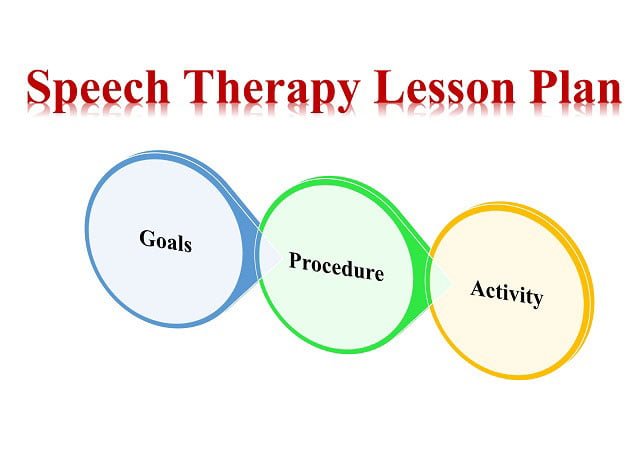
Speech Therapy Lesson Plan – Goals Procedures and Activities
Speech Therapy Lesson Plan – Goals Procedures and Activities: The importance of speech therapy lies in its ability to empower individuals to communicate effectively, participate in social interactions, and succeed in academic and professional settings. A well-structured Speech Therapy Lesson Plan can pave the way for significant improvements, boosting self-esteem and enhancing overall quality of life.
Speech Therapy Lesson Plan – Goals, Procedures, and Activities: A Comprehensive Outline
Heading | Description |
1. Understanding the Basics of Speech Therapy | Introduction to speech therapy, its significance, and the speech therapist’s role in the therapeutic process. |
2. Setting Clear Goals for Speech Therapy | Establishing specific, measurable, achievable, relevant, and time-bound (SMART) goals for each client. |
3. Identifying Individual Needs and Challenges | Assessing clients’ speech and language skills to determine their strengths and areas that require improvement. |
4. Tailoring Customized Lesson Plans | Creating personalized lesson plans based on each client’s unique needs, challenges, and learning style. |
5. Developing Speech and Language Objectives | Defining clear objectives for improving articulation, language comprehension, fluency, and other speech-related skills. |
6. Incorporating LSI Keywords in Lesson Plans | Using latent semantic indexing (LSI) keywords to enhance the lesson plan’s relevance and search engine visibility. |
7. Engaging and Interactive Activities | Exploring a wide range of fun and interactive activities to keep clients motivated and eager to participate in therapy. |
8. Incorporating Technology in Therapy | Utilizing digital tools and apps that can complement traditional speech therapy techniques and engage tech-savvy clients. |
9. Speech Therapy Through Play | Integrating play-based therapy to make the learning process enjoyable for children and individuals with special needs. |
10. Incorporating Real-Life Situations | Encouraging clients to practice their speech and language skills in real-life scenarios to promote generalization of skills. |
11. Tracking Progress and Measuring Success | Implementing data-driven approaches to monitor clients’ progress and adapt the lesson plan as needed for optimal results. |
12. Working Collaboratively with Clients’ Support System | Involving parents, caregivers, teachers, and other relevant individuals in the therapy process to create a supportive network. |
13. Addressing Challenges and Adjusting Strategies | Identifying potential obstacles in therapy and adapting strategies to ensure clients’ success in reaching their goals. |
14. Culturally Sensitive Speech Therapy | Understanding the cultural background of clients and incorporating culturally sensitive practices in therapy sessions. |
15. Encouraging Communication and Self-Expression | Fostering an environment where clients feel comfortable expressing themselves and building their confidence in communication. |
16. Supporting Individuals with Special Needs | Tailoring the lesson plan to accommodate clients with special needs, such as those with autism spectrum disorder (ASD). |
17. Building Speech Fluency and Confidence | Employing techniques to enhance speech fluency and boost clients’ confidence in their communication abilities. |
18. Augmentative and Alternative Communication (AAC) | Introducing AAC methods and technologies to aid individuals with severe speech impairments in expressing themselves. |
19. Articulation Therapy Techniques | Exploring various articulation therapy techniques to improve speech clarity and pronunciation for better communication. |
20. Language Stimulation Strategies | Utilizing language stimulation strategies to promote language development and comprehension in clients of all ages. |
21. Social Skills and Pragmatic Language | Addressing social communication challenges and helping clients develop appropriate pragmatic language skills for interactions. |
22. Incorporating Multimodal Approaches | Utilizing multimodal approaches that combine visual, auditory, and tactile stimuli to enhance learning and retention. |
23. Fostering Independence and Self-Advocacy | Empowering clients to take ownership of their therapy journey, encouraging self-advocacy, and setting personal goals. |
24. Building Lasting Rapport and Trust | Establishing a strong therapist-client relationship built on trust, empathy, and understanding for effective therapy. |
25. Embracing Continuing Education and Growth | Emphasizing the importance of ongoing professional development to stay updated on the latest trends and therapies in the field. |
Planning for Speech and Language Therapy
Planning for Speech and Language Therapy involves a structured approach to address communication disorders and improve speech and language skills.
Let’s create an example of a structured speech and language therapy plan for a child with a communication disorder
Client: Sarah (6-year-old)
Assessment Results:
- Difficulty with articulation (pronunciation of certain sounds)
- Limited vocabulary and difficulty with sentence structure
- Trouble with following multi-step instructions
- Difficulty expressing feelings and needs verbally
Goals:
- Improve articulation skills: Sarah will correctly produce the /r/ and /l/ sounds in words with 80% accuracy within 3 months.
- Expand vocabulary and sentence structure: Sarah will use at least five new age-appropriate words per week in sentences during therapy sessions for the next 6 months.
- Enhance auditory processing: Sarah will follow three-step instructions with visual cues in therapy sessions with 90% accuracy within 2 months.
- Foster expressive language: Sarah will use descriptive language to express her feelings and needs during role-play activities with 75% accuracy within 4 months.
Intervention Techniques:
- Articulation exercises using mirrors and tactile cues for /r/ and /l/ sounds.
- Vocabulary games and picture cards to practice using new words in sentences.
- Visual aids and modeling for multi-step instruction comprehension.
- Role-play scenarios to encourage expressive language and emotional expression.
Therapy Plan:
- Weekly 45-minute therapy sessions for 6 months.
- Session 1-2: Focus on articulation exercises with target sounds.
- Session 3-4: Introduce new vocabulary and practice using them in sentences.
- Session 5-6: Work on auditory processing with visual cues.
- Session 7-8: Engage in role-play activities to foster expressive language and emotional expression.
- Provide Sarah’s parents with home practice activities for articulation and vocabulary expansion.
Data Collection:
- Document Sarah’s accuracy in articulation exercises and vocabulary use during each session.
- Record the percentage of multi-step instructions followed correctly.
- Note Sarah’s progress in expressing feelings and needs during role-play activities.
Collaboration:
- Communicate regularly with Sarah’s parents to update them on progress and discuss home practice.
- Coordinate with Sarah’s school teacher to reinforce language goals in the classroom.
Progress Reviews:
- Review Sarah’s progress every month and adjust therapy techniques accordingly.
- Celebrate milestones and improvements to boost Sarah’s confidence and motivation.
Ongoing Professional Development:
- Stay informed about the latest research and techniques in speech and language therapy to optimize Sarah’s progress.
By following this structured plan, Sarah’s speech and language skills will be systematically addressed, leading to improved communication and overall confidence.
Activities for Speech Therapy
Effective speech therapy activities can make the learning process enjoyable and productive. Incorporating a variety of engaging activities can keep clients motivated and eager to participate. Here are some creative and effective activities for speech therapy:
- Story Building: Encourage clients to construct stories using pictures, engaging their imagination and practicing their narrative skills.
- Articulation Charades: Play charades, focusing on specific speech sounds to promote articulation practice in a fun and interactive way.
- Interactive Apps: Utilize speech therapy apps that offer interactive exercises to target various speech and language skills.
- Role-Playing: Engage in role-playing scenarios to practice communication skills in real-life situations.
- Tongue Twisters: Have fun with tongue twisters to improve speech clarity and dexterity.
- Show and Tell: Encourage clients to bring items of interest and describe them, improving language expression and vocabulary.
Procedures for Speech Therapy
Establishing well-structured procedures ensures the smooth implementation of the speech therapy lesson plan and helps track clients’ progress. Below are essential procedures to incorporate in speech therapy sessions:
- Initial Assessment and Evaluation: Conduct a comprehensive evaluation to understand the client’s speech and language abilities.
- Goal Setting and Planning: Collaborate with the client and their support system to establish specific therapy goals and a customized plan.
- Session Preparation: Prepare materials, activities, and resources required for each therapy session.
- Warm-Up Activities: Start sessions with engaging warm-up activities to set a positive tone and encourage participation.
- Main Activities: Implement targeted speech and language activities based on the established goals.
- Data Collection: Document the client’s progress and collect data to assess their development over time.
Conclusion
In conclusion, the speech therapy plan has been effective in achieving positive outcomes, significantly improving the individual’s speech and language abilities, and empowering them to communicate more confidently and effectively in various social and academic settings.
Frequently Asked Questions
What is the significance of speech therapy?
Speech therapy is significant as it empowers individuals to communicate effectively, participate in social interactions, and succeed in academic and professional settings. It helps improve speech and language skills, boost self-esteem, and enhance overall quality of life.
What is a Speech Therapy Lesson Plan?
A Speech Therapy Lesson Plan is a structured outline that guides speech therapists in addressing communication disorders and improving speech and language skills in clients. It involves setting goals, procedures, and engaging activities to facilitate progress.
How can I create a personalized speech therapy plan for someone with a communication disorder?
To create a personalized plan, you need to assess the individual’s strengths and challenges, set specific goals, choose suitable intervention techniques, and regularly review progress. Collaboration with the client and their support system is essential.
What are some effective speech therapy activities?
Effective speech therapy activities include story building, articulation charades, interactive apps, role-playing, tongue twisters, and show and tell. These activities make learning enjoyable and productive.
What are the key procedures in speech therapy sessions?
Essential procedures in speech therapy sessions involve conducting initial assessments and evaluations, setting goals, preparing for sessions, incorporating warm-up activities, implementing main activities, and consistently collecting data to monitor progress.
How long does it take to see improvements in speech therapy?
The timeline for improvement varies depending on the individual’s specific needs and the severity of their communication disorder. Some clients may show improvements within a few weeks, while others may require several months or more.
What is the role of family and support systems in speech therapy?
Involving the client’s family, caregivers, and teachers in the therapy process is essential. They can provide support, practice at home or in educational settings, and reinforce the speech therapy goals to promote success.
Is speech therapy only for children?
Speech therapy is not limited to children; it can benefit individuals of all ages. It is effective in addressing communication disorders in both children and adults.
What are the latest trends and techniques in speech therapy?
The field of speech therapy is continually evolving. Speech therapists should engage in ongoing professional development to stay updated on the latest research, technologies, and techniques to provide the best possible therapy for their clients.
How can I find a qualified speech therapist for myself or a family member?
You can find a qualified speech therapist by contacting local healthcare providers, schools, or speech therapy clinics. You can also ask for recommendations from your primary care physician or search online directories for licensed and certified speech therapists in your area.
References:
- Treatment Resource Manual for speech-language pathology 5th edition Froma P. Roth, colleen K. wor [Book]
- Clinical Methods and Practicum in Speech-Language Pathology M. N. Hegde, Ph. D.Deborah Davis, M.A [Book]
- Assessment in Speech Language Pathology A Resource Manual 5th Edition, Kenneth G. Shipley, Julie G. McAfee [Book]
- Introduction to communication sciences and disorders – Gary Weismer, David K. Brown [Book]
- The Speech-Language Pathology Treatment Planner – Keith Landis [Book]
You are reading about:
Speech Therapy Lesson Plan – Goals Procedures and Activities




0 Comments